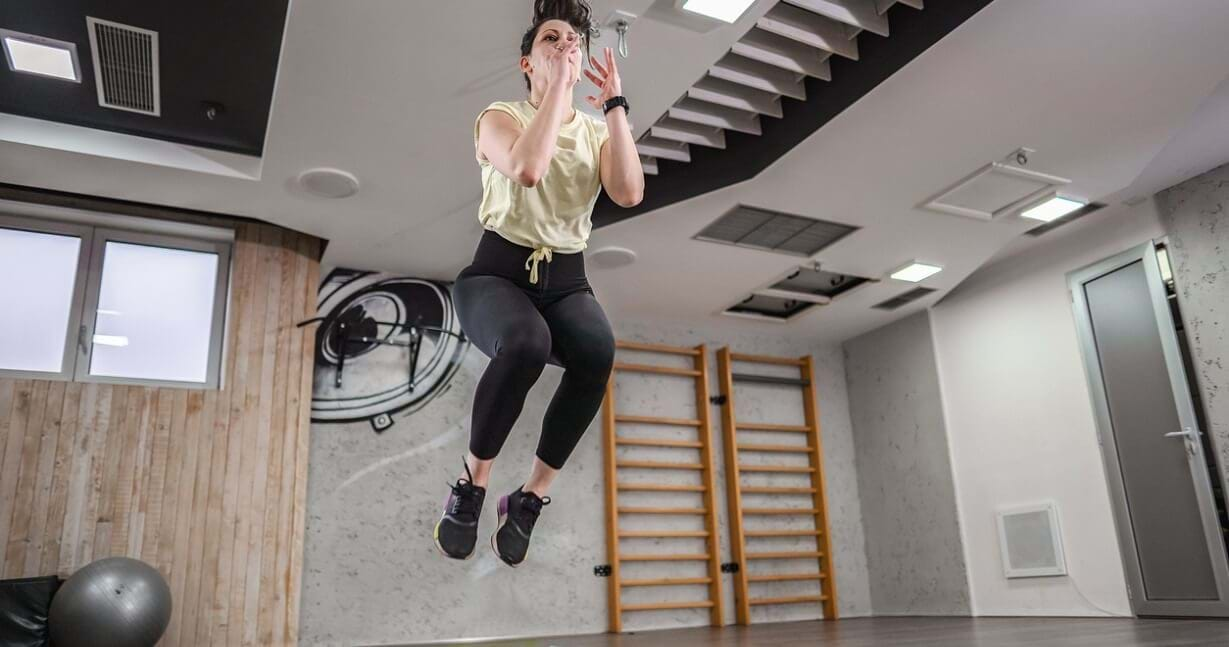Lateral Jumps
What are Lateral Jumps?

Lateral jumps are a dynamic plyometric exercise that work the muscles of the lower body and train the body in the lateral plane of movement (side to side) by pushing off both feet and jumping sideways.
This jump variation is a multi-joint, full body exercise, with the quads, hamstrings, glutes, and adductors primarily targeted. The core muscles also work isometrically to stabilise the torso as you move from side to side.
Benefits of lateral jumps include building lower body power, improving athletic performance, increasing bone density and muscle mass, and burning calories. Compared to other jumps, lateral jumps strengthen important muscles in the hips, glutes, and adductors which are sometimes neglected in leg workouts.
Lateral jumps are suitable for a range of fitness levels, from beginner to advanced. They can be incorporated into warm-ups, lower body strength training, or high-intensity cardio sessions. If you're new to plyometric exercises, start with 2-3 sets of 5-8 reps per side and focus on landing technique. As you build strength and coordination, you can do more reps or take shorter rests between sets.
Lateral jumps can put more stress through the knees and ankles compared to vertical jumps. Proper form is crucial to avoid injury, so pay attention to your technique, especially landing and pushing off the outside foot. If you've got lower body joint issues, either do shorter sets or choose a lower impact alternative to lateral jumps.
Take a look at our technique tips for lateral jumps below.
Check out some other jump exercises: Box Jumps, Pike Jumps, Tuck Jumps, Broad Jumps
Commonly Asked Questions About Lateral Jumps
Lateral jumps are a dynamic plyometric exercise that raises the heart rate, burns calories, and builds lower body power, lateral agility, balance, and body control. They can help you develop change-of-direction speed which is important for a lot of sports. Lateral jumps also work muscles in the outer hips, glutes, and adductors which many other exercises do not target.
A lateral jump into a broad jump is a challenging plyometric exercise that combines the sideways movement of a lateral jump with the forward movement of a broad jump. Start with a powerful lateral jump, driving off one foot and swinging the opposite arm. Bring both feet to the ground underneath your hips, squat down, and use your arms to propel you into a long forwards jump. As you land from the broad jump, perform a lateral jump to the opposite side of your first lateral jump.
Doing an agility ladder as part of your cardio workout adds extra coordination to lateral jumps. Set up the ladder on the floor and stand to one side. Jump sideways, landing with one foot in a ladder square. Hop laterally through the ladder, keeping your chest upright. Focus on fast feet and good landing mechanics.
For a lateral jump over a bar, set up a barbell with plates (this will ensure the bar is off the ground). Stand sideways to the bar and perform a lateral jump over the bar. Land softly, keep an upright posture, and build momentum jumping left to right over the bar.
Lateral Jump Tips
- Use your arms to help build momentum and increase the height and distance of your jump.
- Keep the knees bent on take-off and landing, and land softly on the balls of your feet.
- Keep your chest up to avoid twisting the upper body.
How To Do Lateral Jumps
Stand with your feet shoulder-width apart, knees slightly bent.
Bend your hips and knees to load your leg muscles.
Swing your arms back in preparation for the sideways jump.
As your arms swing forward, push through your feet and extend the hips to jump sideways.
As you jump, tuck your knees up towards your chest.
Land softly on the balls of your feet, keeping your knees and hips bent to help absorb the impact.
If taking off and landing on both feet is difficult, you can perform lateral jumps by taking off and landing on the outside foot.
Jump side to side, maintaining a steady rhythm.
If you’re not sure if any of the above exercises are suitable for you, please consult your doctor before you start it. Need guidance on how to perform the exercise? Ask a personal trainer at your gym.